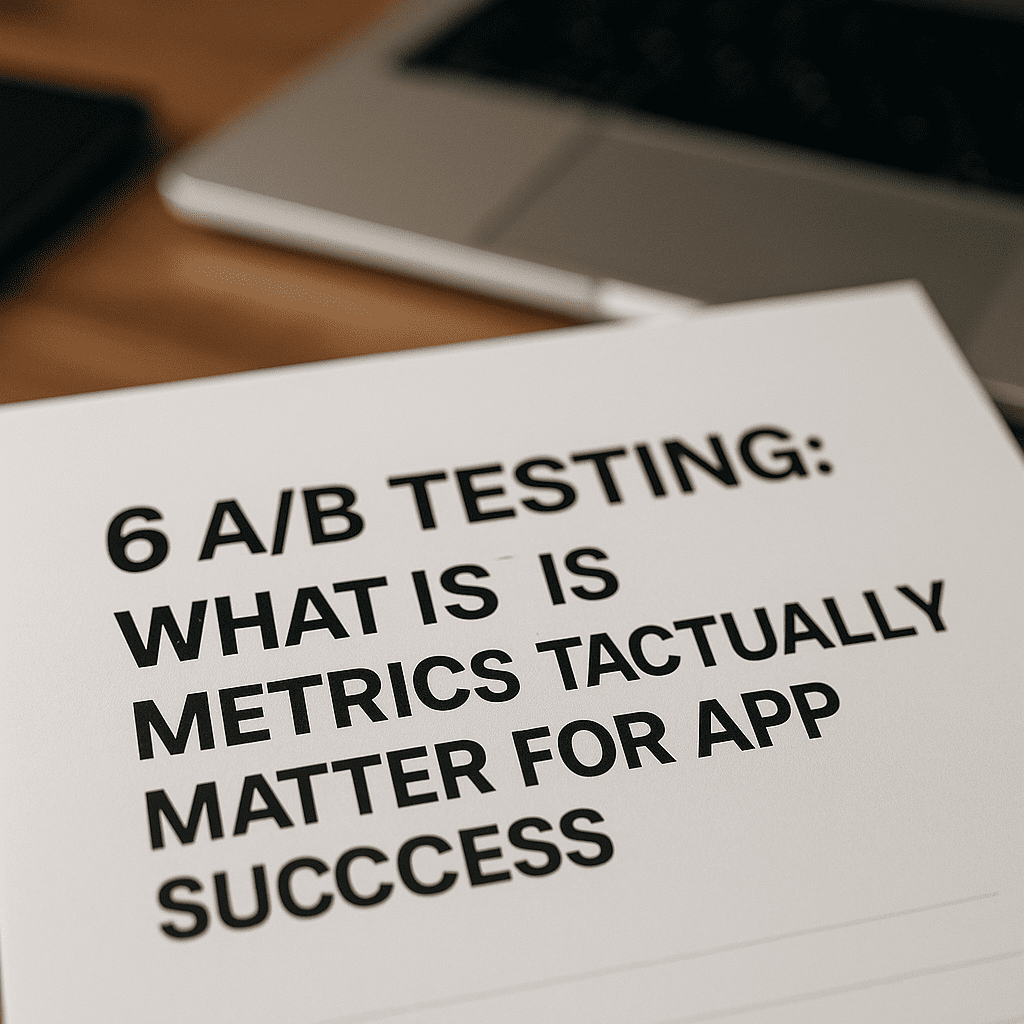
6 A/B Testing Metrics That Actually Matter for Mobile App Growth
In an era of rising user acquisition costs and tighter privacy regulations, mobile marketers need precision. A/B testing is the cornerstone of data-driven optimization—yet not all metrics deliver equal insight. This guide, authored with the rigor of a top growth agency CMO, uncovers the six metrics that truly drive app performance and revenue. You’ll learn how to measure, interpret, and act on each one, ensuring every test moves the needle on engagement, retention, and monetization.
Why Metrics-Driven A/B Testing Is Non-Negotiable
Guesswork hurts your budget and undermines user experience. Metrics-focused A/B testing empowers you to:
- Validate hypotheses with real user data
- Prioritize changes that yield the highest ROI
- Uncover friction points in onboarding, payment flows, or content discovery
- Maintain a culture of continuous optimization across product, marketing, and design teams
Without clear metrics, tests become vanity experiments—expensive and inconclusive.
The 6 Essential Metrics for App A/B Tests
1. Conversion Rate
Definition: The percentage of users who complete a target action—install-to-registration, free-to-paid upgrade, tutorial completion, etc.
Formula:
Conversion Rate = (Number of Conversions ÷ Total Unique Visitors) × 100
Why It Matters: It’s the primary indicator of funnel efficiency. Even a 1–2% lift in purchase or sign-up rates can multiply revenue over time.
Optimization Tactics:
- Refine call-to-action copy (e.g., “Sign Up Free” vs. “Start Your Trial”)
- Reduce form fields—ask only for essential information
- Personalize onboarding with a segmented walkthrough based on user source
- Leverage social proof (reviews, testimonials) within the flow
2. Revenue per User (ARPU/ARPPU)
Definition: Average revenue generated per user (ARPU) or paying user (ARPPU) over a defined period.
Formula:
ARPU = Total Revenue ÷ Total Users
ARPPU = Total Revenue ÷ Number of Paying Users
Why It Matters: Moves beyond raw revenue to measure value at the user level—crucial for pricing tests, feature gating, and loyalty programs.
Optimization Tactics:
- Experiment with tiered subscriptions or micro-transactions
- Test limited-time discounts vs. permanent price points
- Validate premium feature bundles via in-app messaging
- Leverage ad revenue or IAP integration tests for hybrid models
3. Retention Rate
Definition: The percentage of users who return to your app at specific intervals (Day 1, Day 7, Day 30).
Formula:
Retention (Day N) = (Number of Users Who Opened App on Day N ÷ Number of Users Who Installed on Day 0) × 100
Why It Matters: Acquiring new users can cost up to 25× more than retaining existing ones. High retention signals sustained value and reduces churn.
Optimization Tactics:
- Test push notification cadence and copy (see best practices)
- Experiment with in-app messages promoting new features or content
- Implement time-based loyalty rewards (e.g., daily streaks)
- Use contextual triggers to send re-engagement offers
4. Click-Through Rate (CTR)
Definition: The ratio of clicks received on a CTA, banner, or feature prompt to the number of times it was viewed.
Formula:
CTR = (Total Clicks ÷ Total Impressions) × 100
Why It Matters: Indicates how persuasive your design and copy are in driving users toward desired actions—critical for upsells and cross-promotions.
Optimization Tactics:
- Test button colors, sizes, and placement against different backgrounds
- Compare action-oriented phrases (“Upgrade Now” vs. “Learn More”)
- Use heatmap tools to validate element prominence
- Run sequential tests: first design, then copy, then placement
5. Bounce Rate
Definition: The percentage of sessions where users exit after viewing a single screen or dismiss the app without any interaction.
Formula:
Bounce Rate = (Single-Interaction Sessions ÷ Total Sessions) × 100
Why It Matters: High bounce rates reveal blockers—poor loading speed, confusing UI, irrelevant content—that stop users from engaging further.
Optimization Tactics:
- Test simplified UX flows for key entry points
- Optimize screen load times with asset compression
- Clarify on-screen value propositions and CTAs
- Validate iconography and label changes with micro-tests
6. Average Session Duration
Definition: The average time users spend in your app per session.
Formula:
Avg. Session Duration = Total Time Spent in App ÷ Total Sessions
Why It Matters: Indicates overall engagement—longer sessions often mean deeper feature adoption, while shorter sessions can be ideal for quick-utility apps.
Optimization Tactics:
- Experiment with content recommendations to boost time-on-app
- Introduce gamified elements or progress bars
- Test layout changes that surface sticky content
- Measure impact of educational tooltips vs. walkthroughs
Implementing an Impactful A/B Testing Framework
Successful A/B testing is a disciplined process. Follow these five steps to ensure every experiment yields reliable, actionable insights:
Step 1: Align on Clear Hypotheses
Every test starts with a hypothesis: a statement that links a proposed change to an expected metric outcome. Example:
“Changing the ‘Start Free Trial’ button to ‘Unlock Premium Features’ will increase trial sign-ups by 8% within 14 days.”
Step 2: Calculate and Achieve Statistical Power
Use tools like Google’s Analytics Sample Size Calculator to determine the minimum user count for 95% confidence. Run tests long enough to capture typical weekly cycles and avoid false positives.
Step 3: Test One Variable at a Time
Isolated tests prevent attribution errors. If you change CTA text and color simultaneously, you won’t know which drove the lift. Implement multivariate testing only after mastering single-variable A/B tests.
Step 4: Segment Your Audience
Aggregate data can mask critical insights. Drill down by:
- New vs. returning users
- Platform (iOS vs. Android)
- Acquisition channel (paid ads, organic search, referrals)
- Geography and device type
Step 5: Monitor Guardrail Metrics
Focus on your primary metric (e.g., conversion rate) but monitor secondary metrics like retention and load time to ensure no negative side effects. A win in one area shouldn’t harm the broader user experience.
Common Pitfalls and How to Avoid Them
- Stopping Tests Prematurely: Ensure statistical significance before making decisions.
- Over-Segmenting: Too many subgroups dilute sample sizes—focus on the highest-impact segments.
- Ignoring External Variables: Account for holidays, promotions, and app updates that can skew behavior.
- Chasing Insignificant Wins: Small lifts (<1%) may not justify development costs—prioritize high-impact hypotheses.
- Misreading Data: Statistical significance ≠ business significance. Combine quantitative results with qualitative feedback.
Scaling Your Optimization Program
A/B testing thrives in organizations that embed experimentation into their roadmap. Equip cross-functional teams with clear processes, shared dashboards, and a test-first mindset. Leverage platforms like Firebase Remote Config, Optimizely, or Admiral Media’s proprietary testing suite to automate targeting, tracking, and reporting.
Conclusion: From Experiments to Exponential Growth
By focusing on the six metrics that truly matter—conversion rate, revenue per user, retention rate, click-through rate, bounce rate, and average session duration—you move beyond vanity KPIs. You build a repeatable process that identifies friction, validates solutions, and scales wins. In the competitive mobile landscape, this disciplined approach to A/B testing separates the fast followers from the category leaders.
Ready to transform your mobile app into a growth engine? Contact Admiral Media to design and execute a bespoke A/B testing roadmap that maximizes ROI while navigating the evolving privacy landscape.
